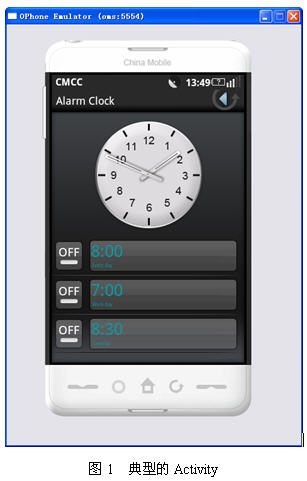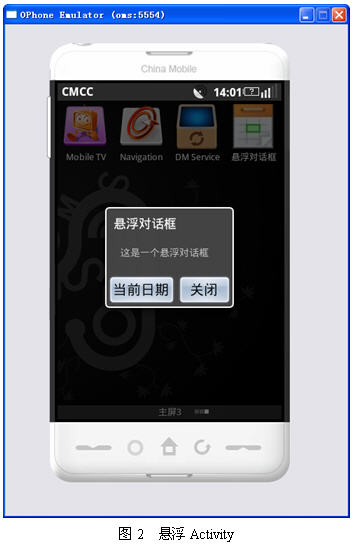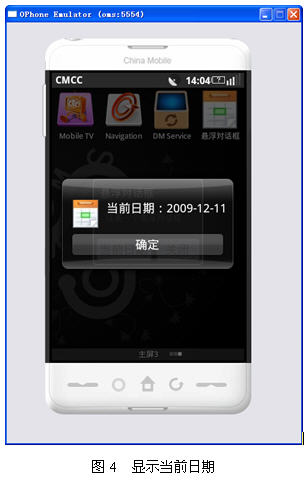本文為原創(chuàng),如需轉(zhuǎn)載,請(qǐng)注明作者和出處,謝謝!
Activity是Ophone系統(tǒng)的4個(gè)應(yīng)用程序組件之一。通過(guò)傳統(tǒng)方法顯示的Activity都是充滿整個(gè)屏幕,也就是全屏的Activity。事實(shí)上,Activity不僅可以全屏顯示,還可以象對(duì)話框一樣直接顯示在屏幕上。而且可以通過(guò)單擊屏幕的任何位置(包括Activity內(nèi)部和Activity外部)來(lái)關(guān)閉Activity。
Activity的傳統(tǒng)風(fēng)格
Activity是學(xué)習(xí)Ophone的入門(mén)技術(shù)。幾乎所有的初學(xué)者都會(huì)從Activity學(xué)起。因此,Activity這個(gè)組件對(duì)于Ophone的開(kāi)發(fā)人員是再熟悉不過(guò)了。下面來(lái)看一下Activity的基本配置。
<activity android:name=".Main" android:label="@string/app_name">
<intent-filter>
<action android:name="android.intent.action.MAIN" />
<category android:name="android.intent.category.LAUNCHER" />
</intent-filter>
</activity>
上面的配置代碼是一個(gè)典型的Activity配置。在這個(gè)配置中主要指定了action和category。按著這個(gè)配置顯示的Activity會(huì)充滿整個(gè)屏幕。在Ophone中也內(nèi)置了很多程序,大多數(shù)都會(huì)包含Activity,例如,圖1是一個(gè)時(shí)鐘程序,也是一個(gè)典型的Activity。

懸浮Activity
所謂懸浮Activity,就是懸浮在桌面上,看起來(lái)象一個(gè)對(duì)話框。如圖2所示。

事實(shí)上,實(shí)現(xiàn)上面的效果并不復(fù)雜,只需要在AndroidManifest.xml文件中定義Activity的<activity>標(biāo)簽中添加一個(gè)android:theme屬性,并指定對(duì)話框主題即可,代碼如下:
<?xml version="1.0" encoding="utf-8"?>
<manifest xmlns:android="http://schemas.android.com/apk/res/android"
package="net.blogjava.mobile"
android:versionCode="1"
android:versionName="1.0">
<application android:icon="@drawable/date" android:label="@string/app_name">
<activity android:name=".Main" android:label="@string/app_name" android:theme="@android:style/Theme.Dialog">
<intent-filter>
<action android:name="android.intent.action.MAIN" />
<category android:name="android.intent.category.LAUNCHER" />
</intent-filter>
</activity>
</application>
<uses-sdk android:minSdkVersion="3" />
</manifest>
當(dāng)使用上面的配置代碼時(shí),顯示的Activity就會(huì)如圖2所示。在本例中向Activity添加了兩個(gè)按鈕,分別用來(lái)顯示當(dāng)前日期和關(guān)閉對(duì)話框。Activity的布局文件的內(nèi)容如下:
<?xml version="1.0" encoding="utf-8"?>
<LinearLayout xmlns:android="http://schemas.android.com/apk/res/android"
android:orientation="vertical" android:layout_width="fill_parent"
android:layout_height="fill_parent">
<TextView android:layout_width="fill_parent"
android:layout_height="wrap_content" android:text="這是一個(gè)懸浮對(duì)話框"
android:layout_marginLeft="20dp" android:layout_marginRight="20dp" />
<LinearLayout xmlns:android="http://schemas.android.com/apk/res/android"
android:orientation="horizontal" android:layout_width="fill_parent"
android:layout_height="fill_parent" android:gravity="center"
android:layout_marginTop="20dp">
<Button android:id="@+id/btnCurrentDate"
android:layout_width="100dp" android:layout_height="wrap_content"
android:text="當(dāng)前日期" />
<Button android:id="@+id/btnFinish" android:layout_width="80dp"
android:layout_height="wrap_content" android:text="關(guān)閉" />
</LinearLayout>
</LinearLayout>
這兩個(gè)按鈕的單擊事件代碼如下:
public void onClick(View view)
{
switch (view.getId())
{
case R.id.btnCurrentDate:
// 顯示當(dāng)前日期對(duì)話框
SimpleDateFormat simpleDateFormat = new SimpleDateFormat(
"yyyy-MM-dd");
dateDialog.setIcon(R.drawable.date);
dateDialog.setTitle("當(dāng)前日期:"
+ simpleDateFormat.format(new Date()));
dateDialog.setButton("確定", new OnClickListener()
{
@Override
public void onClick(DialogInterface dialog, int which)
{
}
});
dateDialog.setOnDismissListener(new OnDismissListener()
{
@Override
public void onDismiss(DialogInterface dialog)
{
new DateDialog.Builder(Main.this).setMessage(
"您已經(jīng)關(guān)閉的當(dāng)前對(duì)話框.").create().show();
}
});
dateDialog.show();
break;
case R.id.btnFinish:
// 關(guān)閉懸浮Activity
finish();
break;
}
}
單擊“顯示日期”按鈕后,效果如圖4所示。

觸摸任何位置都可以關(guān)閉的對(duì)話框
通常需要單擊“關(guān)閉”或其他類(lèi)似的按鈕來(lái)關(guān)閉Activity或?qū)υ捒颉5袝r(shí)需要單擊(觸摸)屏幕的任何位置來(lái)關(guān)閉Activity或?qū)υ捒颉jP(guān)閉Activity很好處理,只需要處理Activity的觸摸事件即可,代碼如下:
@Override
public boolean onTouchEvent(MotionEvent event)
{
finish();
return true;
}
如果是對(duì)話框,也同樣可以使用onTouchEvent事件方法。不過(guò)一般使用了AlertDialog對(duì)話框都是封裝好的。因此,要使用onTouchEvent事件方法,就需要繼承AlertDialog類(lèi)。在上一節(jié)給出的onClick方法中彈出當(dāng)前顯示對(duì)話框的代碼中使用了一個(gè)DateDialog類(lèi),該類(lèi)是AlertDialog的子類(lèi),代碼如下:
package net.blogjava.mobile;
import android.app.AlertDialog;
import android.content.Context;
import android.view.MotionEvent;
public class DateDialog extends AlertDialog
{
public DateDialog(Context context)
{
super(context);
}
@Override
public boolean onTouchEvent(MotionEvent event)
{
// 關(guān)閉顯示日期對(duì)話框
dismiss();
return super.onTouchEvent(event);
}
}
在上面的代碼中也使用了onTouchEvent事件方法。在該方法中調(diào)用了dismiss方法來(lái)關(guān)閉對(duì)話框。讀者可以運(yùn)行本文的例子,看看是否能通過(guò)單擊屏幕的任何位置來(lái)關(guān)閉對(duì)話框和懸浮Activity。
總結(jié)
本文介紹了懸浮Activity和觸摸任何位置都可以關(guān)閉的對(duì)話框的實(shí)現(xiàn)。懸浮Activity只需要在<activity>元素中添加android:theme="@android:style/Theme.Dialog"即可。要想觸摸任何位置關(guān)閉對(duì)話框或Activity,需要使用觸摸事件(onTouchEvent方法)。如果是對(duì)話框,需要通過(guò)繼承AlertDialog類(lèi)的方式來(lái)使用onTouchEvent方法。
新浪微博:http://t.sina.com.cn/androidguy 昵稱(chēng):李寧_Lining